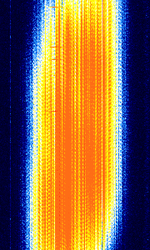SIMONe meteor radar
| Radars | |
|---|---|
| Military: 🇮🇷 🇷🇺 'Ghadir' OTH Radar (Iran/Russia "Rezonans") - 🇷🇺 29B6 'Kontayner' OTH Radar (Russia) - 🇷🇺 Podsolnukh 'Sunflower' Radar (Russia) - 🇨🇳 Chinese 'Foghorn' OTH radar (China) - 🇨🇳 'OTH-SW' OTH Radar (China) 🇦🇺 Jindalee Operational Radar Network (JORN) (Australia) - 🇨🇾 🇬🇧 PLUTO II OTH Radar (Cyprus/UK Base) - 🇺🇸 Relocatable Over-the-Horizon Radar (ROTHR) (US) Civil: 🌎 🌊 CODAR (Worldwide) - 🇺🇸 High Frequency Active Auroral Research Program (HAARP) (Alaska, US) *VHF |
 | |
|---|---|
| Frequencies | 32.55 MHz |
| Frequency Range | 32.55 MHz - 32.55 MHz |
| Mode | AM |
| Modulation | PSK,DSSS |
| ACF | — |
| Emission Designator | — |
| Bandwidth | 140 kHz |
| Location | Worldwide |
| Short Description | The SIMONe radar is a meteor detection system that is operated in multiple research sites around the world. It uses continuous spread-spectrum coded transmissions which gives it an unusual sound when demodulated into audio. It can be received over long distances during sporadic-E and other special propagation conditions. |
| I/Q Raw Recording | Download file |
| Audio Sample | |
The SIMONe radar, short for Spread spectrum Interferometric multistatic Meteor radar Observing Network, is a meteor detection system that is operated in multiple sites around the world, currently mainly in Europe and South America [1]. The SIMONe radar networks implement the MMARIA research concept (Multistatic Multifrequency Agile Radar for Investigations of the Atmosphere). Each network consists of multiple transmitters and receivers in different locations, with all transmitters sharing the same frequency. The radar uses spread-spectrum technology with pseudo-random phase modulated coding to identify the sources of the received signals. [2]
Code repetition interval of the transmission is 10 msmilliseconds (.001 of a second) which gives the signal a 100 HzHertz (Hz), unit of frequency, defined as one cycle per second (1 Hz). tone when it's demodulated into audio as AMAmplitude Modulation or FMFrequency Modulation. Symbol length is 10 µs. Nominal bandwidth of the signal is 100 kHzKiloHertz (kHz) 10^3 Hz but in practice it spreads a bit more. It may have been defined as -3 dBThe decibel (dB) is a logarithmic unit used to express the ratio of two values of a physical quantity, here the strength of a received signal. bandwidth or in a similar way.
The SIMONe radar can be identified based on the unusual sound with 100 HzHertz (Hz), unit of frequency, defined as one cycle per second (1 Hz). tone, lack of pulsed or FMCW signal structure, bandwidth, and the transmission frequency of 32.55 MHzMegaHertz (MHz) 10^6 Hz which is used by most transmitters. Under normal propagation conditions, SIMONe can't usually be received beyond line of sight, but special propagation modes such as sporadic E sometimes allow reception much further away. Reception of the signal reflections from meteors may be possible by using sensitive equipment and a good antenna.
Samples[edit]
This sample was recorded in northern Europe on 29th of June 2024 during good sporadic E conditions.
FMFrequency Modulation sample:
Frequencies[edit]
Radars in one SIMONe network use the same frequency, and most SIMONe networks around the world seem to use 32.55 MHzMegaHertz (MHz) 10^6 Hz.
Video Examples[edit]
Additional Links[edit]
Additional Images[edit]
References[edit]
- ↑ Leibniz-Institut für Atmosphären Physik: SIMONe systems - https://www.iap-kborn.de/forschung/abteilung-radarsondierungen/instrumente/meteorradare/simone-radar-networks/
- ↑ Huyghebaert et al.: Multiple E-Region Radar Propagation Modes Measured by the VHFVery High Frequency (30-300 MHz) SIMONe Norway System During Active Ionospheric Conditions - https://www.frontiersin.org/journals/astronomy-and-space-sciences/articles/10.3389/fspas.2022.886037/full